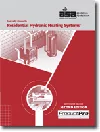Small and large graywater systems
Such systems are viable options for your green-conscious customers.


|
|
Purple graywater piping. Photo credit: Merit Mecha |
First, a clarification. You will find the terms “graywater” and “greywater” used to describe the reuse of certain waters. Whether you prefer an “a” or an “e,” it is the same water. It’s dirty but not disgusting. Nobody has yet to claim the proper spelling of the water. So expect to continue to see “gray” and “grey.”
Simply stated, graywater is all the water discharged down the drain with the exception of water from a water closet, urinal or kitchen sink. The reason for excluding those fixtures should be somewhat obvious. Urine and fecal matter comes from water closets and urinals. Food waste discharges from kitchen sinks.
Graywater is really the capturing of unclean water that is free from solid matters. There is no denying that some solids are discharged from other fixtures, but for the most part, the quantities of solids is minimal.
Most contractors are under the mistaken believe that graywater systems are for large commercial buildings. That is not true. The beauty of a graywater system is that it can be installed in any building. The problem with such systems is the plumbing codes limit them to subsurface irrigation. The system is a drain field for all practical purposes.
Putting in an underground drain field seems like a lot of work for reusing graywater. That’s true. However, think of it as being equivalent to installing an underground sprinkler system to water the lawn. Now, instead of using potable water, you recycle the water that went down the sink, lavatory, shower or bathtub.
The more sophisticated graywater systems are actually reclaimed or reused water systems. You read about using reclaimed water to flush water closets and urinals, or spray vegetation and lawns. The reason these are not graywater systems is because the water must be treated. Graywater is considered contaminated water. You don’t want that water showing up in a water closet or urinal. It might look as if the fixture wasn’t flushed. Similarly, you wouldn’t want that dirty water spraying the lawn or plants.
The treatment can be simple to complex, depending on the type of system. One system is a combination lavatory-and-water-closet flushing system. A tank is installed under the lavatory to collect the water used for washing hands and other activities. A filter is installed in the tank to separate any solids or particulates that may be in the water. Then a sanitizing tablet is used to cleanse the water. This clean water is pumped to the water closet tank when the water closet is flushed.
If you are wondering about not having enough water in the tank below the lavatory, you don’t have to worry. The water closet is still connected to the potable water system. The graywater system prevents the ballcock from activating until the storage tank runs out of water.
This sound like a complicated system, but it is really quite simple. It does require an electrical connection, but otherwise it is just piping from the lavatory to the storage tank and from the storage tank to the water closet.
However, routine maintenance is required for this system. The filter used to separate the solids must be periodically cleaned or replaced. The sanitizing tablet also has to be refilled every few months. Overall, this provides a simple green system for people that would like to reclaim some of their graywater.
This is perhaps the simplest system I have encountered. It is quite ingenious. From there, you start to get more complex systems, such as whole-house systems. Again, filter and sanitizers clean the water. The water can be reused for flushing the water closet or watering the lawn.
The larger the system, the more complex it becomes. For commercial buildings, typically the engineer will design the system meeting all the new plumbing code requirements. If the graywater is to be converted for use above ground, then filtering, sanitizing and maintenance become critical. Additionally, the water must be periodically tested for cleanliness. We are no longer looking at a simple system.
Underground irrigation
The alternative to a complex system is a large underground irrigation system. By keeping the system a truly graywater system, you only need storage tanks and pumps to supply a subsurface irrigation field. Again, it looks like a glorified septic system drain field. Anyone who grew up with a septic system knows the grass always grows greener over the septic field.
In many ways, a true graywater system is going back in time. It is an effective way of irrigating. Plus, it saves water by not having to use potable water for the lawn or plants.
But unlike the good old days, we have more modern piping material to install for the drain fields. It is a lot easier to use slotted plastic pipe than the old bituminous pipe. Many of the storage tanks are blow-mold polyethylene, which are are less expensive and easy to install.
Graywater system installation is something you should be offering your customers. Retrofitting to add graywater systems is another option you should consider offering. With public opinion swinging toward green, a graywater system becomes a viable option. Don’t thumb your nose at these systems as being a phase or latest trend.
Graywater systems provide water conservation as well as an environmentally friendly alternative to discharging all the water to the sewage treatment system. Besides, it adds a lot of additional piping to a project. There is nothing wrong with more work when the public is asking for these green systems.
HELPFUL LINKS:
Looking for a reprint of this article?
From high-res PDFs to custom plaques, order your copy today!






